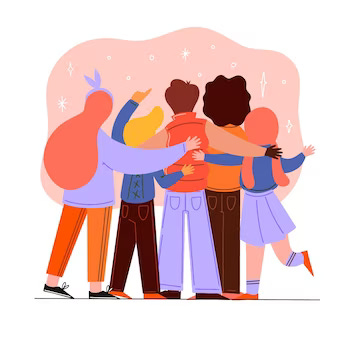I thought I’d take a whirl at writing something other than a monologue of my meandering thoughts about the ways life looks right now. What an absolute treat for you all. I’ve had the bare bones of a draft for this sitting, waiting, begging me to be written for weeks now. Bits and pieces pulled together from different influences, that made little sparks fly in my brain.
It’s been a while though. Writing something new that's not entirely focused on the intricacies of pretty much just talking through my day-to-day. I’m rusty! But I’ve made it all so much easier for myself by branding ‘Drafting’ as the place to do just that. To dish out some of my drafts just as they are. to give it a go. To try things and not fear failure. Substack in general is a great place for that. Come as you are, dear writers! So, perhaps it won’t be the best thing I’ve written (so humble, so self-deprecating). Done is better than perfect.
This particular draft has centred around female friendships, relationships and the longevity of female connections. An enigma I dare not attempt to solve, or even barely scratch the surface of in a mere 800-word piece of writing.
Pondering on female friendship isn’t something new to me. I’ve actually written about it before. Sort of. This piece is about the female flatshare, a relatively new phenomenon disrupting age-old traditions of a woman moving only from the house their father owned to that of her husband once she got married. Yuck. It’s really been no more than 50 years since women have lived together en masse. It’s fair to say the mere opportunity, and the experience itself, have helped to enrich friendships. Here’s a strange little snippet to entice you if you haven’t read it before.
… What I liked most about “my Robbie Williams phase” was the fact someone was there to witness it. It’s kind of like that philosophy of the tree falling in the forest - if no one’s around to hear it, does it make a sound? If I lived alone no one would have been there to hear me listening to Robbie Williams in the shower it would never have resulted in being defined, rather distinctly, as “my Robbie Williams phase”.
I read something Chanté Joseph wrote for The Guardian about the depictions of female friendship on TV. The article was heavily under the influence of our favourite TV gal pals in Sex and The City. Of course, the show is not without its fault as elements have aged poorly over time, something Joseph herself makes clear from the get-go. She explores the portrayal of female friendships and how it shapes our view of our own relationships. The “ironclad bond” between the four women being something she struggled to relate to, having a wider circle of one-on-one friends rather than a core group. Feeling as though she “missed the girl gang boat”. Joseph rounds off appealing for more shows that “debunk the idea that straight men and women can’t be friends”, reinforcing that real friendships have no stipulations or limitations.
Especially within the media, female friendships are viewed as an impenetrable thing. Even a little witchy. Mysterious. Dangerous? They have the power to disrupt the course of things, it seems. With women a minority in the broader production, direction and writing of TV and film, perhaps this opens up another avenue as to why Joseph doesn’t feel seen when it comes to the realities of her own friendships.
Something else I read that made me think about the dynamics of female friendship was The Collapse of Supermodelmania by Farrah Storr. Deep diving into how the lack of authenticity now has created an environment in which the ‘Supers’ of modelling can no longer survive. It goes without saying there are a myriad of reasons as to why supermodels no longer have the draw they once did. Perpetuating ideals of women’s appearances tastes a little sour to us all now. But let’s not digress, I’m here to look at the friendship of the 90s supermodel ‘Trinity’, Naomi Campbell, Christy Turlington and Linda Evangelista.
… And life really was more authentic back then, captured as it was by the late backstage fashion photographer, Roxane Lowit. ‘The Trinity’ were genuine friends (Christy and Linda even lived together) supporting one another with ferocious loyalty behind the scenes. Evangelista and Turlington would famously not take a booking unless Campbell, then one of the few models of colour, was also booked.
Ironically what the original Supers did was demonstrate the very modern idea that women succeed when they stick together. They proved that what was actually more powerful than beauty alone, was authenticity, genuine female friendship and eye-watering transparency when it comes to money and success. Which in today’s world, makes them a very rare breed indeed.
Girl power! Am I right ladies? I am intensely and irrevocably grateful for every female friendship I have in my life. For the flatshares, the groups and the one-on-ones. That’s not to say I value my friendships with people who aren’t women any less. I think I’m just a little fascinated by the way in which women have forged and carved out spaces for themselves in this slice of recent history. I’m with Chanté Joseph on calling for more depictions of friendships without stereotypical bounds or divides in gender, age, class… All of my friends are dear to me. Especially, as I’ve found over the past few weeks during the tougher times. Where would we be without friendship?






I genuinely haven't thought before about just how recent the phenomenon of the flatshare is, Mary! How? Still, I'm glad to have had a wee lightbulb moment reading this and the chance to reflect on the flatshares of my own youth. There are many stories I could tell of those times...